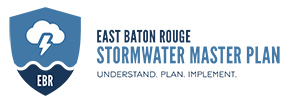Hazard Mitigation Grant Projects (HMGP)
FEMA’s Hazard Mitigation Grant Program provides funding to state, local, tribal and territorial governments so they can rebuild in a way that reduces, or mitigates, future disaster losses in their communities. This grant funding is available after a presidentially declared disaster. Please see below for brief project descriptions.
Port Hudson Pride Road Stream Bank Stabilization
Pride-Port Hudson Road serves as an important corridor for the City of Zachary in northern East Baton Rouge Parish. This project focuses on an area of streambank northeast of the Port Hudson Pride Road bridge crossing over the Comite River. The current roadway and bridge are at risk of failure from flood related hazards, such as erosion/undercutting and displacement/destruction of the road structure. This project’s goal is to stabilize the roadway and bridge to avoid those risks.
The photo shows the erosion along this section of the Comite River. If left in this current condition, the Comite River is expected to erode the streambank until reaching the Port Hudson Pride Road crossing, therefore rendering that section of road unusable and making closure necessary. Closure of this roadway to address necessary repairs would require at least 120 days of repair and an at least 12-minute detour. To avoid these measures, the project will focus on adding rip rap and weirs along the approximate 1100 feet of streambank. The addition of rip rap to this area will ensure that the streambank remains intact. Additionally, erosion prevention will protect the Comite River bridge crossing, ensuring that neither displacement nor destruction occurs in the event of heavy rains or riverine flooding. This will reinforce the streambank, re-establish the stream’s natural flow path and prevent further erosion while preventing road failure as a result.
The total cost of this project is $3.19 million, with 75% of this funding from the FEMA Hazard Grant Mitigation Program. This funding is supplemented with East Baton Rouge’s local match of 25%, which will be paid for by the Louisiana Watershed Initiative. The design phase of this project is nearing completion.
Hurricane Creek Slope Paving Near Plank Road
The Plank Road bridge crossing at Hurricane Creek, approximately 2500 feet south of the Airline Highway and Plank Road intersection, is near an area of streambank experiencing erosion due to high water velocities. This project’s goal is to address erosion issues along the Hurricane Creek streambank to minimize risks to Plank Road and the adjacent cemetery.
The photo shows the erosion along Hurricane Creek due to damaged and missing concrete slabs along the streambank. If conditions continue, erosion is expected to encroach into the adjacent cemetery, impacting the gravesites, JH Cooney Street, and Plank Road, making road closure a necessary measure. Closure of Plank Road, which experiences between 11,000 and 18,000 cars per day, would require 20 to 30 days of repair and an at least 5-minute detour. To prevent these encroachments and avoid inconvenient road closures, this project will address and repair the erosion along the Hurricane Creek streambank. This will reinforce the streambank and prevent further erosion and encroachment of damaging flood waters.
The total cost of this project is $1.27 million with 75% of this funding from the FEMA Hazard Grant Mitigation Program. This funding is supplemented with East Baton Rouge’s local match of 25%, which will be paid for by the Louisiana Watershed Initiative. This project is currently in the design phase.
New Bridges at Hundred Oaks & Broussard on Dawson Creek
Both Hundred Oaks Avenue and Broussard Street are located in a primarily residential area of Baton Rouge. At these locations, the current culvert crossings over Dawson Creek are experiencing conveyance constrictions resulting in backwater flooding. As a result, the streambank is at risk of over-topping and damaging the surrounding area. The goal of this project is to reduce those risks.
The photos show the current conditions of these crossings along Dawson Creek. If left in this current condition, these crossings are expected to continue to impede channel flow and flood areas upstream of these locations, therefore causing preventable devastation. To avoid these damages, the project will focus on replacing both culvert crossings with bridges. This will open the Dawson Creek channel and prevent further flooding upstream. The newly constructed bridges will reduce channel constrictions, reducing chances of backwater flooding occurring in areas upstream of these locations.
The total cost of this project is $4.37 million, with 75% of this funding from the FEMA Hazard Grant Mitigation Program. This funding is supplemented with East Baton Rouge’s local match of 25%, which will be paid for by the Louisiana Watershed Initiative. This project is currently in the design phase.
Removal of Channel Restriction in Ward Creek at Siegen Lane
Ward Creek is a drainage corridor that drains to Bayou Manchac and receives floodwaters from upstream waterways. An area of interest is where it crosses the former Siegen Lane bridge location. The current channel contains obstructions that are causing flow constrictions, resulting in increased flood risk to surrounding areas. This project focuses on removing the constrictions in Ward Creek at this location.
The photos show the current conditions of this section of Ward Creek. If left in this current condition, Ward Creek is expected to continue to experience reduced channel flow, and to flood areas upstream of this location. To avoid these damages, the project will focus on widening Ward Creek, which will increase channel flow and reduce flooding upstream of this location.
The total cost of this project is $1.4 million, with 100% of this funding from the FEMA Hazard Grant Mitigation Program. This project is nearing design completion.
Ward Creek Distributed Detention Project
The Ward Creek Watershed is one of the most developed watersheds within East Baton Rouge Parish, limiting the availability of stormwater storage sites. In response, the Ward Creek Distributed Detention project intends to identify and construct various detention areas throughout Ward Creek Watershed. These detention sites are green spaces that will provide extra storage for stormwater during peak runoff times and assist with flood risk reduction. Approximately 140 acres will be utilized and cost $30.7M. This project is part of the Hazard Mitigation Grant Program (HMGP). The project is currently in the design phase.

